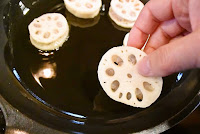Plump shrimp sandwiched between somewhat crunchy lotus root slices, served with slightly salty thickened dashi sauce. Making the shrimp filling (chopping shrimp, mixing with potato starch and egg white) and putting it between lotus root slices may seem complicated at first, but it is easy when you actually try it. The assembled pieces can be kept in the fridge until ready to cook, and sauteing them does not take much time. Below, the pale thickened dashi sauce is made in the microwave for quick preparation as well.
This dish provides soothing comfort on cooler days. As summer approaches here in the Pacific Northwest it is getting a bit too warm for this dish, but we may still have a few nights cool enough to enjoy it ...
This dish provides soothing comfort on cooler days. As summer approaches here in the Pacific Northwest it is getting a bit too warm for this dish, but we may still have a few nights cool enough to enjoy it ...
1/2 of recipe:
76 calories; 6.9 g protein; 1.3 g fat; 9.4 g carbohydrate; 8.4 g net carbs; 85 mg sodium (with 50% reduced-sodium soy sauce); 45 mg cholesterol; 1.0 g fiber; 289 mg potassium
<Ingredients>
Approx. 60 g shelled shrimp (56 g after cleaning with potato starch in photo; 81 g frozen with shell)
1 tsp egg white (approx. 1/8 of one egg white)
1/4 tsp katakuriko potato starch
1-2 tsp flour (to dust lotus root slices)
1 tsp oil
For gin-an light thickened dashi sauce
80 cc dashi
1/4 tsp sake
1/4 tsp mirin
1/4 tsp soy sauce
1/4 tsp shiokoji salted rice malt
1 small knob ginger
2 tsp katakuriko potato starch + 2-3 tsp water
Tiny handful kaiware daikon radish sprouts (14 g in photo)
<Directions>
1.
Skin renkon lotus root slices, and soak in water for several minutes (add some rice vinegar if desired to maintain the pale color).
Chop shrimp, and remove roots of kaiware daikon sprouts.
2.
Add egg white and potato starch to shrimp, and mix well.
3.
Drain lotus root slices, and pat dry both sides.
Place lotus root slices in a single layer, and dust surface (one side only) with flour.
An uneven dusting is OK; too much flour would result in starchy texture at the end.
Place the other slices on top, with flour-dusted side touching shrimp mixture of its counterpart.
Gently press each sandwich.
4.
Heat oil in frying pan; when hot, place sandwiches, cover, and cook at medium to medium low heat for a few minutes (lotus root becomes slightly translucent).
Remove cover, flip, and cook until bottom becomes toasty.
5.
In the meantime, prepare gin-an sauce.
Grate ginger.
Put sake, mirin, soy sauce and shiokoji into dashi, and bring to boil in microwave.
Mix potato starch and water mixture once again, and pour a small amount into dashi mixture, mix well, microwave for 10-15 seconds.
Repeat until desired thickness is achieved.
Maple syrup consistency or looser is recommended.
Add juice from grated ginger, and mix well.
Gin-an sauce is ready.
6.
Plate sauteed lotus root sandwiches and kaiware daikon sprouts, and pour over gin-an sauce.
Serve hot immediately.
<Notes>
- Instead of first cutting necessary portion of lotus root and then slicing, slicing enough rounds directly from a large lotus root section (and saving the rest) is recommended.
- Thicker lotus root slices would require more cooking, which makes shrimp too firm. Slices 3-5 mm thick seem to work best for the recipe above.
- Soaking lotus root slices in water is to prevent discoloration. Adding some rice or grain vinegar to water is very effective but optional, since discoloration is caused by polyphenol, an antioxidant.
- For gin-an pale thickened dashi sauce, I usually use usukuchi pale soy sauce (96 mg sodium per 1/4 teaspoon) for a clearer salty note. I used reduced-sodium regular soy sauce (39 mg sodium per 1/4 teaspoon) for the above because saltiness is already present with shrimp itself. The difference is very minor (approx. 15 mg higher in sodium content per serving if using usukuchi soy sauce), and usukuchi soy sauce probably is better when serving this to people who prefer strong-flavored dishes or are not familiar with reduced-sodium diet.
- The above nutrition figures are based on the assumption that half of gin-an sauce is consumed with lotus root, shrimp and kaiware daikon sprouts.
- Gin-an sauce is not something you eat or drink on its own, and whatever pools in plates or bowls after solids are gone is left untouched.
- Any green vegetable (leafy or not) in season works as a great companion. It can be raw, blanched, steamed, grilled, or sauteed according to desired texture and taste. Just make sure it is not strongly flavored and is at room temperature or warmer, especially in cold seasons.
- Lotus root shrimp sandwiches are very tasty when made into tempura (photo at right; accompanied by shishito tempura).
- Aside from shrimp, (ground) chicken is also commonly made into lotus root sandwiches.





















No comments:
Post a Comment